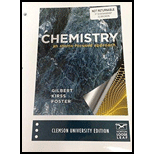
To write:
The balanced equation for the cell for each given pair and identify which half-reaction takes place at the anode and which at the cathode.
Answer to Problem 17.31QA
Solution:
Anode:
Cathode:
------------------------------------------------------------------------------
Balanced equation:
Anode:
Cathode:
------------------------------------------------------------------------------------------------------
Balanced equation:
Anode:
Cathode:
-----------------------------------------------------------------------------------------
Balanced equation:
Explanation of Solution
1) Concept:
We are asked to write and balance the cell reaction from the given pair. Values of standard reduction potential are given in appendix 6, table A6.1. Higher the standard reduction potential, higher is the tendency to reduce. So, the element that has negative or small value of standard reduction potential is more likely to oxidize. Therefore, we reverse that reaction to make it an oxidation half reaction. For an
Adding two half
2) Formula:
3) Given:
i)
ii)
iii)
4) Calculations:
a.
The standard reduction potential values for all these reactions taken from the Appendix 6, table A6.1 are as follows:
Combining the two equations to get the balanced cell reaction:
Anode:
Cathode:
-------------------------------------------------------------------------
Since the standard reduction potential for
b.
Anode:
Cathode:
------------------------------------------------------------------------------------------------------
Since the standard reduction potential for
c.
In this pair of reactions, electrons are not the same, so we need to balance them. Hence, multiply the first reaction by 2, and we get
Anode:
Cathode:
-------------------------------------------------------------------------------------------
Since the standard reduction potential for the second given half reaction is higher than that of
Conclusion:
For an electrochemical cell, reduction occurs at cathode while oxidation occurs at anode.
The element with higher standard reduction potential value will serve as a cathode while the element with a lower standard reduction potential value will serve as an anode.
Want to see more full solutions like this?
Chapter 17 Solutions
Chemistry: An Atoms-Focused Approach
- What is the final product when hexanedioic acid reacts with 1º PCl5 and 2º NH3.arrow_forwardWhat is the final product when D-galactose reacts with hydroxylamine?arrow_forwardIndicate the formula of the product obtained by reacting methyl 5-chloro-5-oxopentanoate with 1 mole of 4-penten-1-ylmagnesium bromide.arrow_forward
- The temperature on a sample of pure X held at 1.25 atm and -54. °C is increased until the sample boils. The temperature is then held constant and the pressure is decreased by 0.42 atm. On the phase diagram below draw a path that shows this set of changes. pressure (atm) 2 0 0 200 400 temperature (K) Xarrow_forwardQUESTION: Answer Question 5: 'Calculating standard error of regression' STEP 1 by filling in all the empty green boxes *The values are all provided in the photo attached*arrow_forwardpressure (atm) 3 The pressure on a sample of pure X held at 47. °C and 0.88 atm is increased until the sample condenses. The pressure is then held constant and the temperature is decreased by 82. °C. On the phase diagram below draw a path that shows this set of changes. 0 0 200 temperature (K) 400 аarrow_forward
 ChemistryChemistryISBN:9781305957404Author:Steven S. Zumdahl, Susan A. Zumdahl, Donald J. DeCostePublisher:Cengage Learning
ChemistryChemistryISBN:9781305957404Author:Steven S. Zumdahl, Susan A. Zumdahl, Donald J. DeCostePublisher:Cengage Learning ChemistryChemistryISBN:9781259911156Author:Raymond Chang Dr., Jason Overby ProfessorPublisher:McGraw-Hill Education
ChemistryChemistryISBN:9781259911156Author:Raymond Chang Dr., Jason Overby ProfessorPublisher:McGraw-Hill Education Principles of Instrumental AnalysisChemistryISBN:9781305577213Author:Douglas A. Skoog, F. James Holler, Stanley R. CrouchPublisher:Cengage Learning
Principles of Instrumental AnalysisChemistryISBN:9781305577213Author:Douglas A. Skoog, F. James Holler, Stanley R. CrouchPublisher:Cengage Learning Organic ChemistryChemistryISBN:9780078021558Author:Janice Gorzynski Smith Dr.Publisher:McGraw-Hill Education
Organic ChemistryChemistryISBN:9780078021558Author:Janice Gorzynski Smith Dr.Publisher:McGraw-Hill Education Chemistry: Principles and ReactionsChemistryISBN:9781305079373Author:William L. Masterton, Cecile N. HurleyPublisher:Cengage Learning
Chemistry: Principles and ReactionsChemistryISBN:9781305079373Author:William L. Masterton, Cecile N. HurleyPublisher:Cengage Learning Elementary Principles of Chemical Processes, Bind...ChemistryISBN:9781118431221Author:Richard M. Felder, Ronald W. Rousseau, Lisa G. BullardPublisher:WILEY
Elementary Principles of Chemical Processes, Bind...ChemistryISBN:9781118431221Author:Richard M. Felder, Ronald W. Rousseau, Lisa G. BullardPublisher:WILEY





